light ACURA ZDX 2010 Manual Online
[x] Cancel search | Manufacturer: ACURA, Model Year: 2010, Model line: ZDX, Model: ACURA ZDX 2010Pages: 645, PDF Size: 17.13 MB
Page 494 of 645
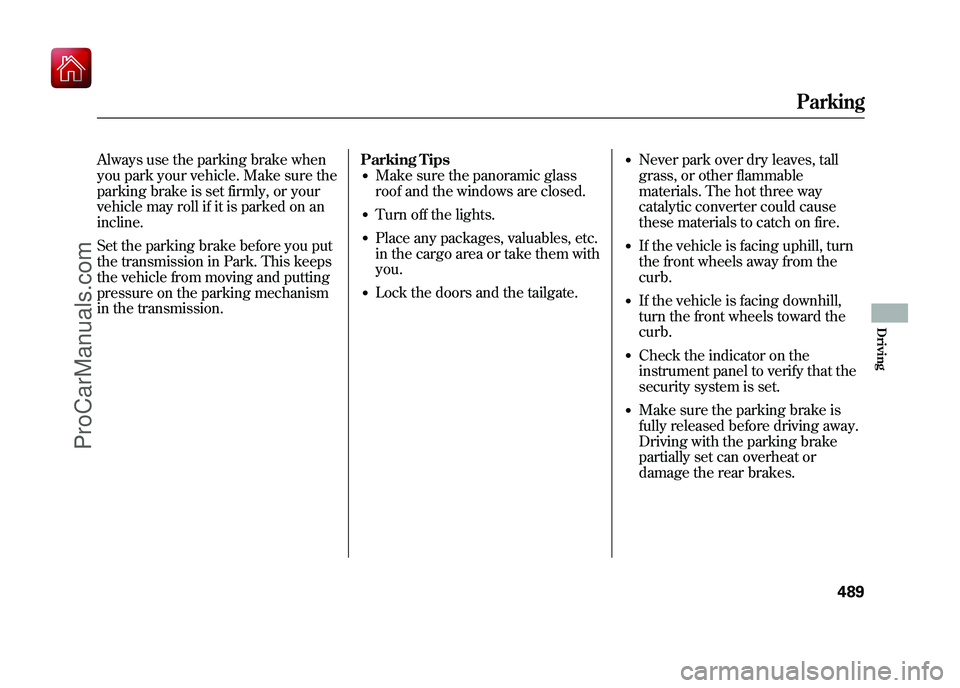
Always use the parking brake when
you park your vehicle. Make sure the
parking brake is set firmly, or your
vehicle may roll if it is parked on an
incline.
Set the parking brake before you put
the transmission in Park. This keeps
the vehicle from moving and putting
pressure on the parking mechanism
in the transmission.Parking Tips
●Make sure the panoramic glass
roof and the windows are closed.●Turn off the lights.●Place any packages, valuables, etc.
in the cargo area or take them with
you.●Lock the doors and the tailgate.
●Never park over dry leaves, tall
grass, or other flammable
materials. The hot three way
catalytic converter could cause
these materials to catch on fire.●If the vehicle is facing uphill, turn
the front wheels away from the
curb.●If the vehicle is facing downhill,
turn the front wheels toward the
curb.●Check the indicator on the
instrument panel to verify that the
security system is set.●Make sure the parking brake is
fully released before driving away.
Driving with the parking brake
partially set can overheat or
damage the rear brakes.
Parking
489
Driving
09/10/28 17:15:37 10 ACURA ZDX KA KC New North America Own 50 31SZN600 enu
ProCarManuals.com
Page 495 of 645
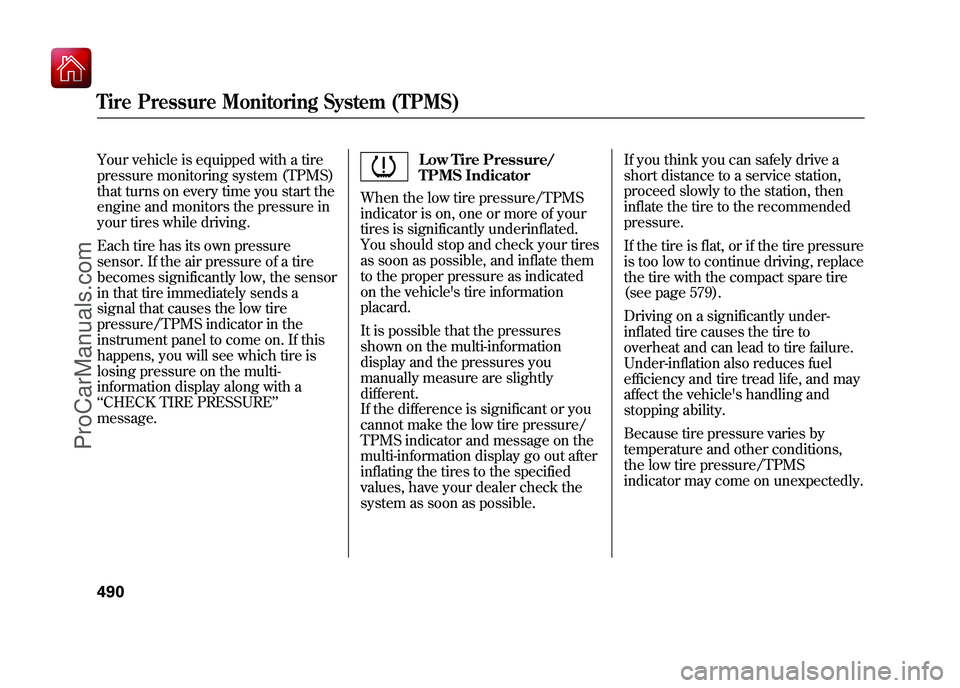
Your vehicle is equipped with a tire
pressure monitoring system (TPMS)
that turns on every time you start the
engine and monitors the pressure in
your tires while driving.
Each tire has its own pressure
sensor. If the air pressure of a tire
becomes significantly low, the sensor
in that tire immediately sends a
signal that causes the low tire
pressure/TPMS indicator in the
instrument panel to come on. If this
happens, you will see which tire is
losing pressure on the multi-
information display along with a
‘‘CHECK TIRE PRESSURE ’’
message.
Low Tire Pressure/
TPMS Indicator
When the low tire pressure/TPMS
indicator is on, one or more of your
tires is significantly underinflated.
You should stop and check your tires
as soon as possible, and inflate them
to the proper pressure as indicated
on the vehicle's tire information
placard.
It is possible that the pressures
shown on the multi-information
display and the pressures you
manually measure are slightly
different.
If the difference is significant or you
cannot make the low tire pressure/
TPMS indicator and message on the
multi-information display go out after
inflating the tires to the specified
values, have your dealer check the
system as soon as possible. If you think you can safely drive a
short distance to a service station,
proceed slowly to the station, then
inflate the tire to the recommended
pressure.
If the tire is flat, or if the tire pressure
is too low to continue driving, replace
the tire with the compact spare tire
(see page 579).
Driving on a significantly under-
inflated tire causes the tire to
overheat and can lead to tire failure.
Under-inflation also reduces fuel
efficiency and tire tread life, and may
affect the vehicle's handling and
stopping ability.
Because tire pressure varies by
temperature and other conditions,
the low tire pressure/TPMS
indicator may come on unexpectedly.
Tire Pressure Monitoring System (TPMS)49009/10/28 17:15:37 10 ACURA ZDX KA KC New North America Own 50 31SZN600 enu
ProCarManuals.com
Page 500 of 645

Your vehicle is equipped with disc
brakes at all four wheels. A power
assist helps reduce the effort needed
on the brake pedal. The emergency
brake assist system increases the
stopping force when you depress the
brake pedal hard in an emergency
situation. The anti-lock brake system
(ABS) helps you retain steering
control when braking very hard.
Resting your foot on the pedal keeps
the brakes applied lightly, builds up
heat, and reduces their effectiveness
and reduces brake pad life. In
addition, fuel economy can be
reduced. It also keeps your brake
lights on all the time, confusing
drivers behind you.Constant application of the brakes
when going down a long hill builds
up heat and reduces their
effectiveness. Use the engine to
assist the brakes by taking your foot
off the accelerator and downshifting
to a lower gear.
Check the brakes after driving
through deep water. Apply the
brakes moderately to see if they feel
normal. If not, apply them gently and
frequently until they do. Be extra
cautious in your driving.
Braking System Design
The hydraulic system that operates
the brakes has two separate circuits.
Each circuit works diagonally across
the vehicle (the left-front brake is
connected with the right-rear brake,
etc.). If one circuit should develop a
problem, you will still have braking
at two wheels.
Brake Wear Indicators
All four brakes have audible brake
wear indicators.
If the brake pads need replacing, you
will hear a distinctive, metallic
screeching sound when you apply
the brake pedal. If you do not have
the brake pads replaced, they will
screech all the time. It is normal for
the brakes to occasionally squeal or
squeak when you apply them.
Braking System
495
Driving
09/10/28 17:15:37 10 ACURA ZDX KA KC New North America Own 50 31SZN600 enu
ProCarManuals.com
Page 503 of 645
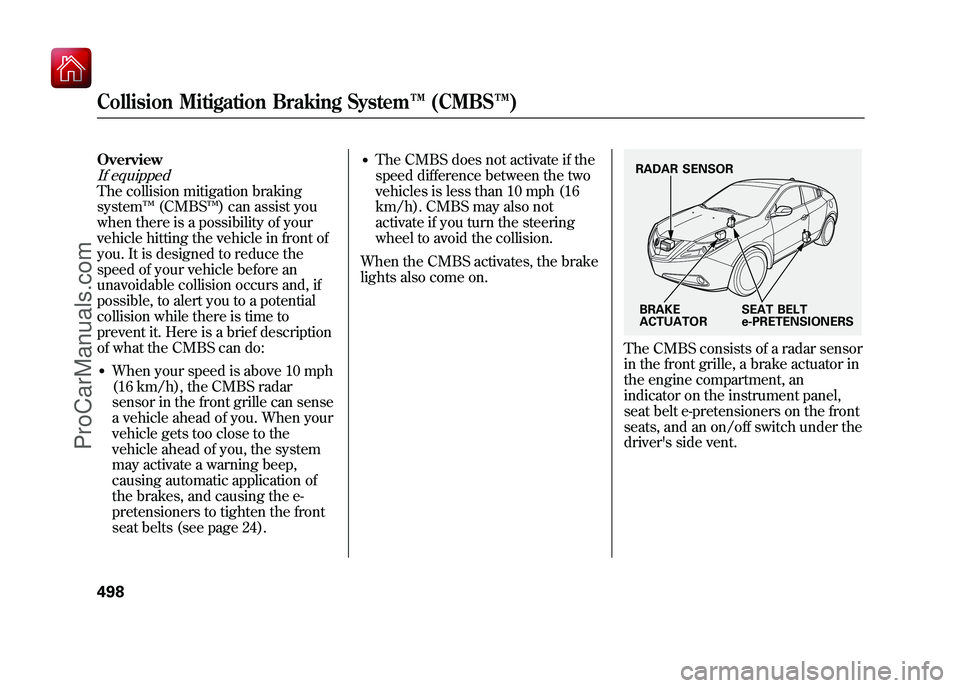
OverviewIf equippedThe collision mitigation braking
system™(CMBS ™) can assist you
when there is a possibility of your
vehicle hitting the vehicle in front of
you. It is designed to reduce the
speed of your vehicle before an
unavoidable collision occurs and, if
possible, to alert you to a potential
collision while there is time to
prevent it. Here is a brief description
of what the CMBS can do:●When your speed is above 10 mph
(16 km/h), the CMBS radar
sensor in the front grille can sense
a vehicle ahead of you. When your
vehicle gets too close to the
vehicle ahead of you, the system
may activate a warning beep,
causing automatic application of
the brakes, and causing the e-
pretensioners to tighten the front
seat belts (see page 24).
●The CMBS does not activate if the
speed difference between the two
vehicles is less than 10 mph (16
km/h). CMBS may also not
activate if you turn the steering
wheel to avoid the collision.
When the CMBS activates, the brake
lights also come on.
The CMBS consists of a radar sensor
in the front grille, a brake actuator in
the engine compartment, an
indicator on the instrument panel,
seat belt e-pretensioners on the front
seats, and an on/off switch under the
driver's side vent.RADAR SENSOR
BRAKE
ACTUATOR SEAT BELT
e-PRETENSIONERS
Collision Mitigation Braking System
™(CMBS™ )49809/10/28 17:15:37 10 ACURA ZDX KA KC New North America Own 50 31SZN600 enu
ProCarManuals.com
Page 506 of 645

Distance between vehicles
CMBS
The radar sensor detects a vehicle E-pretensionerAudio & Visual
WARNINGS Braking
operation
Stage one There is a risk of a
collision with the
vehicle ahead, or the
distance between the
vehicles has dropped
below a certain level.
—
A beep sounds
and
‘‘BRAKE ’’
flashes on the
multi-
information
display.
—
Stage two The distance between
the two vehicles
continues to diminish.Retracts the driver's
seat belt gently a few
times, providing a
physical warning.
Lightly
applied
Stage three
ꭧ
The CMBS determines
that a collision is
unavoidable. Forcefully tightens
driver and front
passenger seat belts.
Forcefullyapplied
ꭧ : Depending on the circumstances, CMBS may not go through all of the alert stages before initiating the last stage.
YOUR
VEHICLE VEHICLE
AHEAD
YOUR
VEHICLEVEHICLE
AHEAD
YOUR
VEHICLEVEHICLE
AHEAD
CONTINUED
Collision Mitigation Braking System
™(CMBS™ )
501
Driving
09/10/28 17:15:37 10 ACURA ZDX KA KC New North America Own 50 31SZN600 enu
ProCarManuals.com
Page 511 of 645
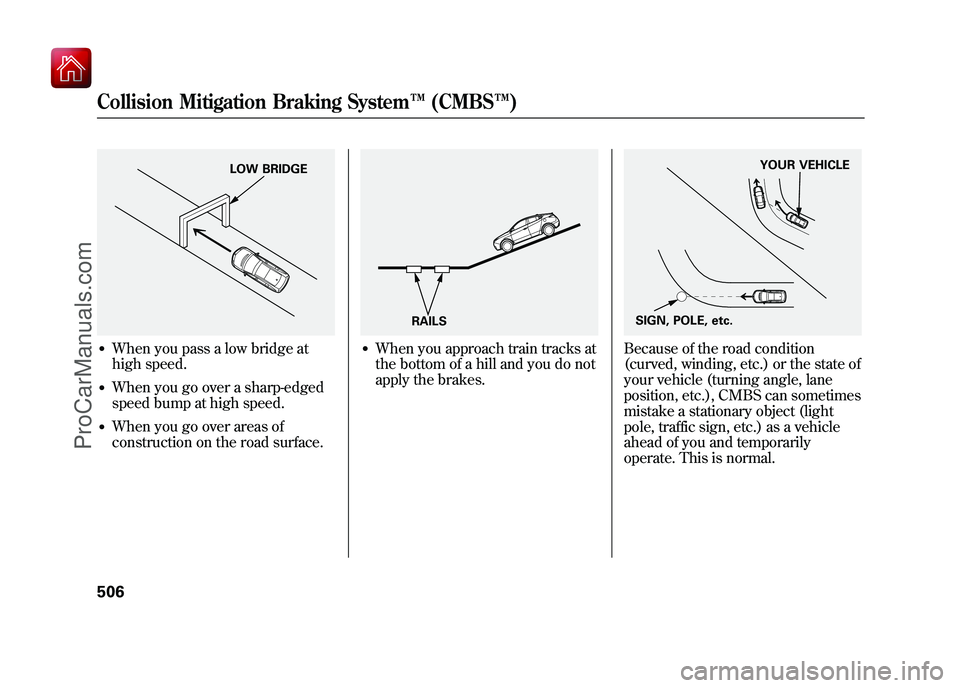
●When you pass a low bridge at
high speed.●When you go over a sharp-edged
speed bump at high speed.●When you go over areas of
construction on the road surface.
●When you approach train tracks at
the bottom of a hill and you do not
apply the brakes.
Because of the road condition
(curved, winding, etc.) or the state of
your vehicle (turning angle, lane
position, etc.), CMBS can sometimes
mistake a stationary object (light
pole, traffic sign, etc.) as a vehicle
ahead of you and temporarily
operate. This is normal.
LOW BRIDGE
RAILS
YOUR VEHICLE
SIGN, POLE, etc.
Collision Mitigation Braking System ™(CMBS™ )50609/10/28 17:15:37 10 ACURA ZDX KA KC New North America Own 50 31SZN600 enu
ProCarManuals.com
Page 523 of 645

BSI Status Displays
SystemStatus Multi-information
display message BSI Indicator Description
ON -
When you set the power mode to ON with the engine start/stop button, the BSI
system indicators on the multi-information display and the instrument panel will
inform you if the system is ON or OFF for about 5 seconds.
The BSI indicator light illuminates or flashes according to the system status.
A chime sounds to indicate that the system has been turned ON or OFF.
OFF
ON/OFF
ꭧ
If while driving, mud, snow, or ice accumulates in the vicinity of sensor:●The system will shut down●The BSI indicator illuminates, a message is displayed on the multi-information
display, and a chime sounds.
The BSI indicator will turn off and the system will return to normal once the obstacle
is removed, and you begin to drive.
Always keep the area around the radar sensors clean. The BSI system may not
operate properly if the sensors are obstructed.
The BSI alert indicator:●May come on when a vehicle enters one of the alert zones, even if this message is
displayed.●May not come on due to obstruction (splashes, etc.), even if this message is not
displayed.
ꭧ : System status may remain on even when the BLIND SPOT NOT AVAILABLE
message is displayed.
OFF If the system is faulty, the BSI indicator light illuminates and a message is displayed
on the multi-information display.
Have your vehicle inspected at your Acura dealer.
Blind Spot Information System (BSI)51809/10/28 17:15:37 10 ACURA ZDX KA KC New North America Own 50 31SZN600 enu
ProCarManuals.com
Page 529 of 645
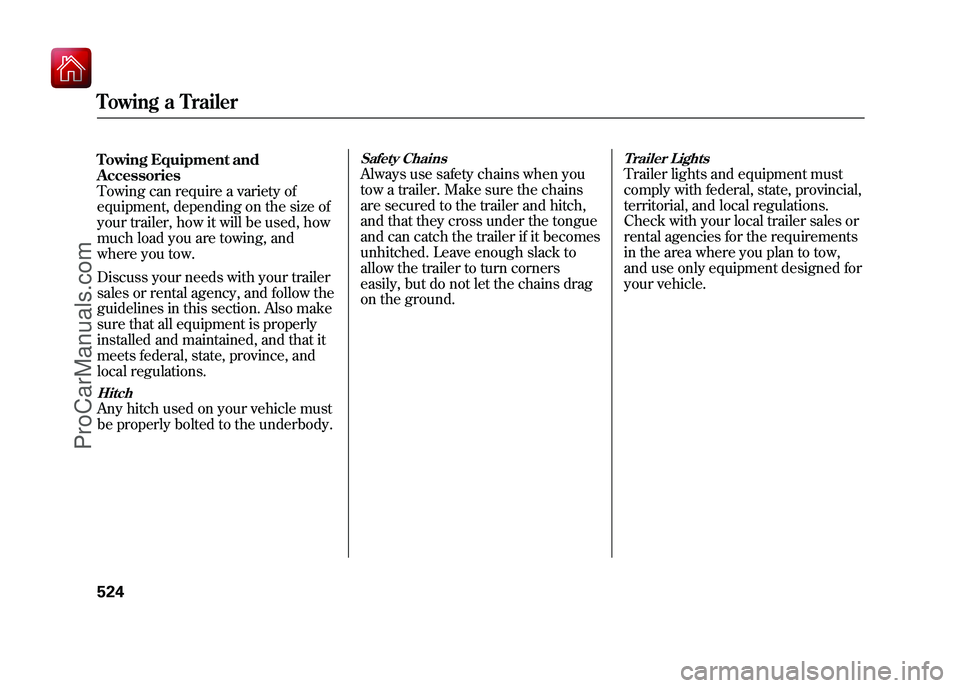
Towing Equipment and
Accessories
Towing can require a variety of
equipment, depending on the size of
your trailer, how it will be used, how
much load you are towing, and
where you tow.
Discuss your needs with your trailer
sales or rental agency, and follow the
guidelines in this section. Also make
sure that all equipment is properly
installed and maintained, and that it
meets federal, state, province, and
local regulations.HitchAny hitch used on your vehicle must
be properly bolted to the underbody.
Safety ChainsAlways use safety chains when you
tow a trailer. Make sure the chains
are secured to the trailer and hitch,
and that they cross under the tongue
and can catch the trailer if it becomes
unhitched. Leave enough slack to
allow the trailer to turn corners
easily, but do not let the chains drag
on the ground.
Trailer LightsTrailer lights and equipment must
comply with federal, state, provincial,
territorial, and local regulations.
Check with your local trailer sales or
rental agencies for the requirements
in the area where you plan to tow,
and use only equipment designed for
your vehicle.
Towing a Trailer52409/10/28 17:15:37 10 ACURA ZDX KA KC New North America Own 50 31SZN600 enu
ProCarManuals.com
Page 530 of 645
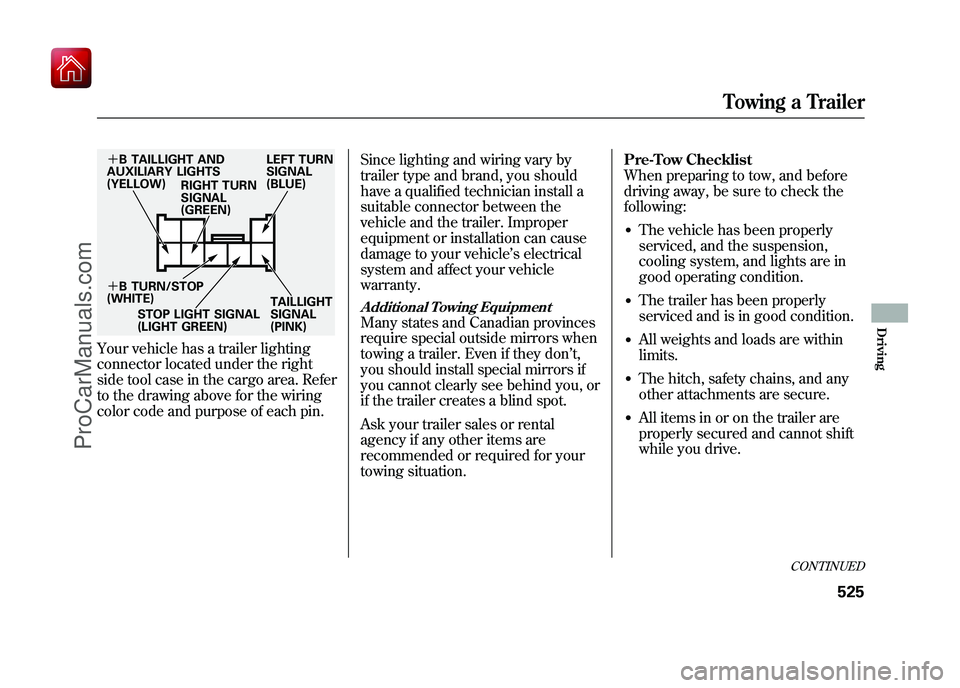
Your vehicle has a trailer lighting
connector located under the right
side tool case in the cargo area. Refer
to the drawing above for the wiring
color code and purpose of each pin.Since lighting and wiring vary by
trailer type and brand, you should
have a qualified technician install a
suitable connector between the
vehicle and the trailer. Improper
equipment or installation can cause
damage to your vehicle
’s electrical
system and affect your vehicle
warranty.
Additional Towing EquipmentMany states and Canadian provinces
require special outside mirrors when
towing a trailer. Even if they don ’t,
you should install special mirrors if
you cannot clearly see behind you, or
if the trailer creates a blind spot.
Ask your trailer sales or rental
agency if any other items are
recommended or required for your
towing situation. Pre-Tow Checklist
When preparing to tow, and before
driving away, be sure to check the
following:
●The vehicle has been properly
serviced, and the suspension,
cooling system, and lights are in
good operating condition.●The trailer has been properly
serviced and is in good condition.●All weights and loads are within
limits.●The hitch, safety chains, and any
other attachments are secure.●All items in or on the trailer are
properly secured and cannot shift
while you drive.
+
B TAILLIGHT AND
AUXILIARY LIGHTS
(YELLOW) RIGHT TURN
SIGNAL
(GREEN) LEFT TURN
SIGNAL
(BLUE)
+ B TURN/STOP
(WHITE)
STOP LIGHT SIGNAL
(LIGHT GREEN) TAILLIGHT
SIGNAL
(PINK)
CONTINUED
Towing a Trailer
525
Driving
09/10/28 17:15:37 10 ACURA ZDX KA KC New North America Own 50 31SZN600 enu
ProCarManuals.com
Page 531 of 645
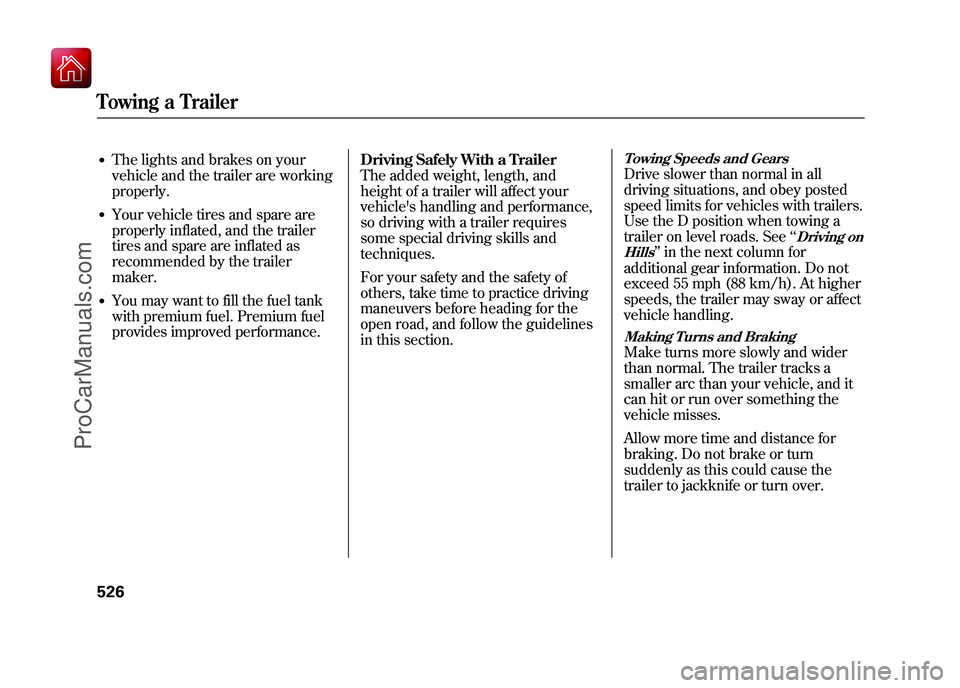
●The lights and brakes on your
vehicle and the trailer are working
properly.●Your vehicle tires and spare are
properly inflated, and the trailer
tires and spare are inflated as
recommended by the trailer
maker.●You may want to fill the fuel tank
with premium fuel. Premium fuel
provides improved performance.Driving Safely With a Trailer
The added weight, length, and
height of a trailer will affect your
vehicle's handling and performance,
so driving with a trailer requires
some special driving skills and
techniques.
For your safety and the safety of
others, take time to practice driving
maneuvers before heading for the
open road, and follow the guidelines
in this section.
Towing Speeds and GearsDrive slower than normal in all
driving situations, and obey posted
speed limits for vehicles with trailers.
Use the D position when towing a
trailer on level roads. See
‘‘
Driving on
Hills
’’ in the next column for
additional gear information. Do not
exceed 55 mph (88 km/h). At higher
speeds, the trailer may sway or affect
vehicle handling.
Making Turns and BrakingMake turns more slowly and wider
than normal. The trailer tracks a
smaller arc than your vehicle, and it
can hit or run over something the
vehicle misses.
Allow more time and distance for
braking. Do not brake or turn
suddenly as this could cause the
trailer to jackknife or turn over.
Towing a Trailer52609/10/28 17:15:37 10 ACURA ZDX KA KC New North America Own 50 31SZN600 enu
ProCarManuals.com